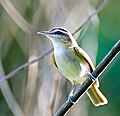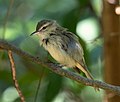| Group | Image | Scientific name | Common name | Distribution |
|---|
| The "hypochryseus" group |  | Golden vireo | Vireo hypochryseus | Mexico |
|---|
| The "olivaceous" group |  | Yellow-green vireo | Vireo flavoviridis | southern Texas, Mexico (the Sierra Madre Occidental and Sierra Madre Oriental—also the Cordillera Neovolcanica) south to central Panama |
|---|
 | Red-eyed vireo | Vireo olivaceus | Canada and the eastern and northwestern United States, Argentina, Uruguay, Paraguay and Bolivia |
 | Yucatan vireo | Vireo magister | Belize, Honduras, Mexico |
 | Black-whiskered vireo | Vireo altiloquus | southern Florida, USA, and the West Indies as far south as the offshore islands of Venezuela |
 | Chivi vireo | Vireo chivi | northeastern Colombia, into Venezuela and the entirety of the Guianas into eastern Brazil |
 | Noronha vireo | Vireo gracilirostris | Fernando de Noronha, Brazil |
| The "gilvus" group | | Tepui vireo | Vireo sclateri | western Guyana and northern Brazil |
|---|
 | Philadelphia vireo | Vireo philadelphicus | Canada to Central America |
 | Warbling vireo | Vireo gilvus | Alaska to Mexico and the Florida Panhandle |
 | Brown-capped vireo | Vireo leucophrys | Southern Mexico south to northwestern Bolivia |
| The "eye-ringed" group |  | Hutton's vireo | Vireo huttoni | southern British Columbia in Canada to central Guatemala in Central America |
|---|
 | Gray vireo | Vireo vicinior | southwestern United States and northern Baja California to western Texas |
 | Yellow-throated vireo | Vireo flavifrons | southern United States, Mexico, the Caribbean, and Central America |
 | Yellow-winged vireo | Vireo carmioli | Costa Rica and western Panama |
 | Choco vireo | Vireo masteri | western Colombia and north-west Ecuador |
 | Blue-headed vireo | Vireo solitarius | Canada and northern United States |
 | Cassin's vireo | Vireo cassinii | southern British Columbia in Canada through the western coastal states of the United States. |
 | Plumbeous vireo | Vireo plumbeus | southeastern Montana and western South Dakota south to the Pacific coast of Mexico |
 | Blue Mountain vireo | Vireo osburni | Jamaica |
 | Flat-billed vireo | Vireo nanus | Hispaniola |
 | Mangrove vireo | Vireo pallens | Belize, Costa Rica, El Salvador, Guatemala, Honduras, Mexico, and Nicaragua |
 | Providencia vireo | Vireo approximans | Isla de Providencia |
 | Cozumel vireo | Vireo bairdi | Mexico |
 | San Andres vireo | Vireo caribaeus | islands of St. Andrew (or San Andrés) and Providencia |
 | White-eyed vireo | Vireo griseus | eastern United States from New England west to northern Missouri and south to Texas and Florida, and also in eastern Mexico, northern Central America, Cuba and the Bahamas |
 | Thick-billed vireo | Vireo crassirostris | West Indies in the Bahamas, Turks and Caicos Islands, Cayman Islands, Tortuga Island in Haiti and Cuba |
| Jamaican vireo | Vireo modestus | Jamaica |
 | Cuban vireo | Vireo gundlachii | Cuba |
 | Bell's vireo | Vireo bellii | Western North America and Central America |
 | Puerto Rican vireo | Vireo latimeri | Puerto Rico |
 | Black-capped vireo | Vireo atricapilla | south from south-central Kansas through central Oklahoma and Texas to central Coahuila, Mexico |
 | Dwarf vireo | Vireo nelsoni | Mexico |
 | Slaty vireo | Vireo brevipennis | southern Mexico |
|









































